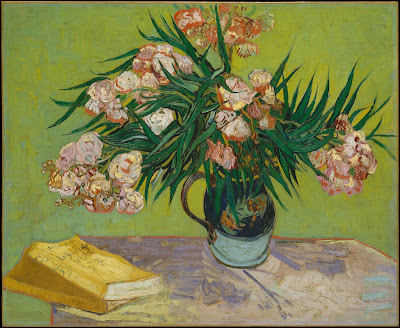 |
| On top of the Old Kirk bell tower overlooking Kirkcaldy. The church here is St. Brycedale Church. |
One of my favorite things about studying art is the opportunities I get to visit new places. I can see images of paintings and sculptures in books or online, but this is no comparison to seeing art in person. There is a type of magic when standing before a work of art; all your senses are involved. I've been to many art museums in the States, and now in Scotland I'm getting the opportunity to branch out to new museums and historic sites.
 |
| Morris & Co. stained glass in St. Brycedale Church, designed by Edward Burne-Jones, circa 1890s. This shows Moses and the burning bush. |
One of the classes I'm taking this semester is a course about the Victorian era English designer, William Morris. Morris opened a design firm, Morris & Co., in 1861 which included producing for sale wallpaper, textiles, chintzes, furniture, and stained glass (among other things). I chose to focus my seminar paper (second of three papers for the class) on Morris stained glass. Morris (and many other glaziers of the time) looked to Medieval stained glass for style and material inspiration. My paper will focus on the revival of stained glass in the Victorian period and how Morris & Co. played a significant role in the revival. There was a need for a revival because before the 1850s-1860s, stained glass was not very good quality and lacked originality. Morris & Co. brought it back!
 |
| Another Morris & Co. window in the Old Kirk, designed by Burne-Jones. The left is Moses and the Egyptians being consumed by the Red Sea and on the right is a scene of Joseph, Mary, and infant Jesus with an angel. Also circa 1890s. |
Today, the William Morris class took a trip to Kirkcaldy, a town a little more than an hour southwest of St. Andrews. There we visited the St. Brycedale Church and the Old Kirk to see three sets of Morris & Co. windows. They were designed by Edward Burne-Jones, the principle stained glass artist of the company as well as good friend of Morris. Burne-Jones was primarily known as being a painter, but his talents overlapped into many different mediums.
 |
| The William Morris class inside the cafe at St. Brycedale Church. On the right is the instructor and behind her are the windows |
One of the distinguishing features of Morris & Co.
windows is the colors. As opposed to typical jewel-like primary colors,
Morris often used earthy greens and browns, deep reds, and rich blues.
Another feature seen in many Morris & Co. windows is the background
foliage which are typical of Morris' patternwork.
 |
| Inside the Old Kirk. The two windows in the picture are both Morris & Co. windows. |
After having breakfast in the little cafe in the St. Brycedale Church, in which there was one of the Burne-Jones windows, we headed over to the Old Kirk to see another set. After seeing these, we headed back into St. Brycedale and looked at the final set of windows in another part of the church. However before this, while still at the Old Kirk, we had the most interesting and unplanned part of the trip: we were able to climb the bell tower.
 |
| The first set of stairs leading up to the bell tower in the Old Kirk. This was the only part with a railing. |
Now I don't know how I end up in the strangest places of old buildings in Scotland (mines, anyone?) but it's definitely worth the minor anxiety of potentially getting trapped or falling off of something high. In the bell tower of the Old Kirk, we were allowed to ring the bell, Quasimodo style, by pulling on the rope attached to it - which I didn't actually get a chance to do but some of the other girls did. Then after this we climbed a narrow set of winding stairs, no railing to hold on to, we emerged out into the open air on a small balcony that went around the whole tower. Inside, we could touch the bell. There was a little mallet and a note saying that the bell played different notes if hit in different parts - so I hit away!
 |
| The bell inside of the Old Kirk, Kirkcaldy. |
So the moral of this story: Study art history, move to a foreign land, climb scary bell towers, and hit bells with tiny mallets. Worked for me :)
Cheers!
(For more pictures from Kirkcaldy, visit my
flickr page!)









